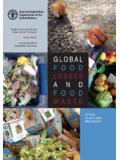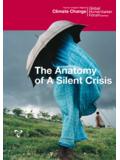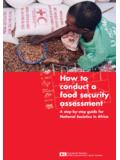Transcription of Global food losses and food waste - Extent, causes and ...
1 104. causes and prevention of food losses and wasteFood is wasted throughout the FSC, from initial agricultural production down to final household consumption. In medium- and high-income countries food is to a high extent wasted, meaning that it is thrown away, even if it is still suitable for human consumption. Significant food loss and waste do, however, also occur earlier in the food supply chain. In low-income countries food is mostly lost during the production-to-processing stages of the food supply industrialized countries food gets lost when production exceeds demand. In order to ensure delivery of agreed quantities while anticipating unpredictable bad weather or pest attacks, farmers sometimes make production plans on the safe side, and end-up producing larger quantities than needed, even if conditions are average.
2 In the case of having produced more than required, some surplus crops are sold to processors or as animal feed. However, this is often not financially profitable considering lower prices in these sectors compared to those from : Communication and cooperation between farmers. Cooperation among farmers could reduce risk of overproduction by allowing surplus crops from one farm to solve a shortage of crops on another (Stuart, 2009).In developing countries and, sometimes, developed countries, food may be lost due to premature harvesting. Poor farmers sometimes harvest crops too early due to food deficiency or the desperate need for cash during the second half of the agricultural season. In this way, the food incurs a loss in nutritional and economic value, and may get wasted if it is not suitable for : Organizing small farmers and diversifying and upscaling their production and marketing.
3 Small resource-poor farmers can be organized in groups to produce a variety of significant quantities of cash crops or animals. In this way they can receive credit from agricultural financial institutions or advance payments from buyers of the 2. Snapshot case: appearance quality standardsCarrot quality standards, by the supermarket chain AsdaAs research for the book waste understanding the Global food scandal (2009), Tristram Stuart visited several British farms in order to understand how quality standards affect the level of food waste . Among others, Stuart visited Poskitt Carrots in Yorkshire, a major supplier to the supermarket chain Asda. At the farm, the author was shown large quantities of out-graded carrots, which, having a slight bend, were sent off as animal feed. In the packing house, all carrots passed through photographic sensor machines, searching for aesthetic defects.
4 Carrots that were not bright orange, had a blend or blemish or were broken were swept off into a livestock feed container. As staff at the farm put it: Asda insist that all carrots should be straight, so customers can peel the full length in one easy stroke (Stuart, 2009). In total, 25-30% of all carrots handled by Poskitt Carrots were out-graded. About half of these were rejected due to physical or aesthetic defects, such as being the wrong shape or size; being broken or having a cleft or a 4 causes and prevention of food losses and waste11 High appearance quality standards from supermarkets for fresh products lead to food waste . Some produce is rejected by supermarkets at the farm gate due to rigorous quality standards concerning weight, size, shape and appearance of crops. Therefore, large portions of crops never leave the farms.
5 Even though some rejected crops are used as animal feed, the quality standards might divert food originally aimed for human consumption to other uses (Stuart, 2009).Prevention: Consumer surveys by supermarkets. Supermarkets seem convinced that consumers will not buy food which has the wrong weight, size or appearance. Surveys do however show that consumers are willing to buy heterogeneous produce as long as the taste is not affected (Stuart, 2009). Consumers have the power to influence the quality standards. This could be done by questioning them and offering them a broader quality range of products in the retail : Sales closer to consumers. Selling farm crops closer to consumers without having to pass the strict quality standards set up by supermarkets on weight, size and appearance would possibly reduce the amount of rejected crops. This could be achieved through, , farmers markets and farm shops (Stuart, 2009).
6 Poor storage facilities and lack of infrastructure cause post-harvest food losses in developing countries. Fresh products like fruits, vegetables, meat and fish straight from the farm or after the catch can be spoilt in hot climates due to lack of infrastructure for transportation, storage, cooling and markets (Rolle, 2006; Stuart, 2009).Prevention: investment in infrastructure and transportation. Governments should improve the infrastructure for roads, energy and markets. Subsequently, private sector investments can improve storage and cold chain facilities as well as transportation (Choudhury, 2006).Unsafe food is not fit for human consumption and therefore is wasted. Failure to comply with minimum food safety standards can lead to food losses and, in extreme cases, impact on the food security status of a country. A range of factors can lead to food being unsafe, such as naturally occurring toxins in food itself, contaminated water, unsafe use of pesticides, and veterinary drug residues.
7 Poor and unhygienic handling and storage conditions, and lack of adequate temperature control, can also cause unsafe : develop knowledge and capacity of food chain operators to apply safe food handling practices. food chain operators should be skilled and knowledgeable in how to produce safe food . Foods need to Box 3. Snapshot case: poor post-harvest facilitiesLack of facilities for rice threshing, drying and winnowing, TajikistanA farmer winnowing rice in Tursunzade, Tajikistan in 2010. Sun drying exposes rice to rodents and parasites, which may eat or damage the harvested crops. Proper storage facilities are also important in order to reduce the amounts of food lost during post-harvest handling and storage. FAO / V. MAxIMOVG lobal food losses and food waste12be produced, handled and stored in accordance with food safety standards. This requires the application of good agricultural and good hygienic practices by all food chain operators to ensure that the final food protects the consumer.
8 Disposing is cheaper than using or re-using attitude in industrialized countries leads to food waste . Industrialized food processing lines often carry out trimming to ensure the end product is in the right shape and size. Trimmings, in some cases, could be used for human consumption but are usually disposed of. food is also lost during processing because of spoilage down the production line. Errors during processing lead to final products with the wrong weight, shape or appearance, or damaged packaging, without affecting the safety, taste or nutritional value of the food . In a standardized production line these products often end up being discarded (Stuart, 2009; SEPA, 2008).Prevention: develop markets for sub-standard products. Both commercial and charity organizations could arrange for the collection and sale or use of discarded sub-standard products that are still safe and of good taste and nutritional value (SEPA 2008).
9 Box 4. Snapshot case: food safety at riskRickshaws transporting milk in BangladeshRickshaws transporting milk from the countryside to processing plants in Baghabarighat, Bangladesh. Transporting milk in the warm and humid climate of Bangladesh without a proper cold chain may cause milk losses . The rickshaw transportation on narrow and winding roads prolongs the time milk is handled in warm 5. Snapshot case: disposing is cheaper than using or re-usingFrench fries production in The NetherlandsDuring his thesis, D. Somsen interviewed a Dutch french fries producer to better understand the causes of food waste in the french fries production line (Somsen, 2004). The company reported several steps in the production line where raw material was lost and wasted, during the size reduction in which potatoes are cut into strips. French fries are fragile and easily break when transported during processing as well as when packaged.
10 The unwanted products are sorted out and occasionally end up wasted. In addition to this, some potatoes are sorted out prior to entering the factory, due to damage during loading, transport from producer to factory and/or during storage. FAO / G. DIAnA H. GrAbErChapter 4 causes and prevention of food losses and waste13 Lack of processing facilities causes high food losses in developing countries. In many situations the food processing industry doesn t have the capacity to process and preserve fresh farm produce to be able to meet the demand. Part of the problem stems from the seasonality of production and the cost of investing in processing facilities that will not be used : develop contract farming linkages between processors and farmer. Governments should create a better enabling environment and investment climate, to stimulate the private sector to invest in the food industry and to work more closely with farmers to address supply quantities on display and a wide range of products/ brands in supply lead to food waste in industrialized countries.















